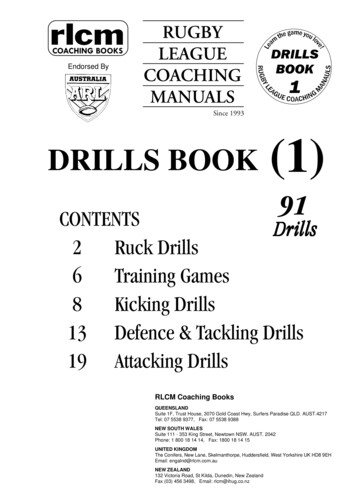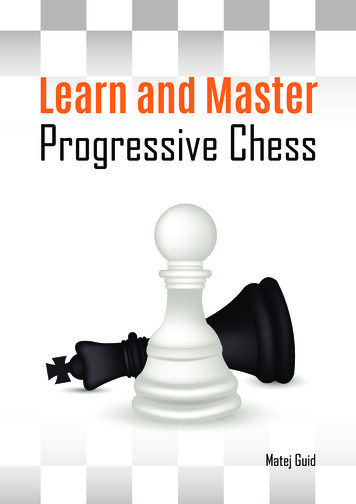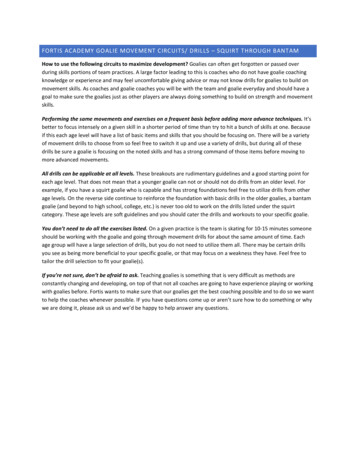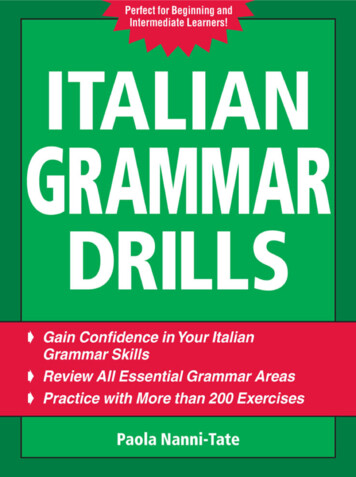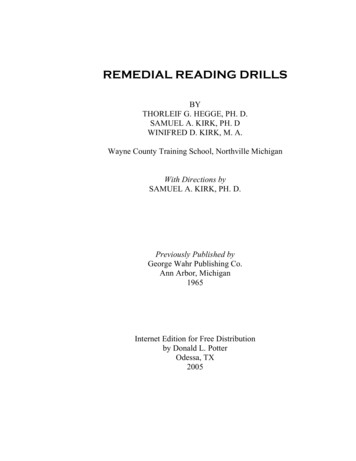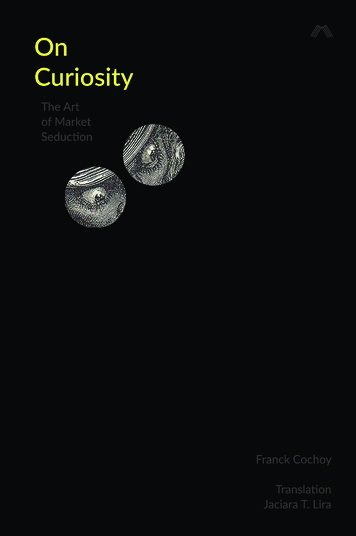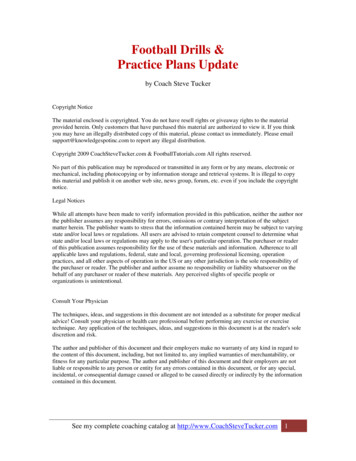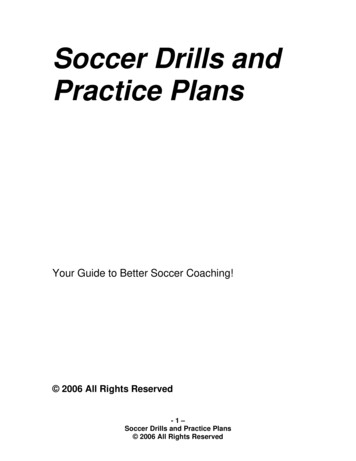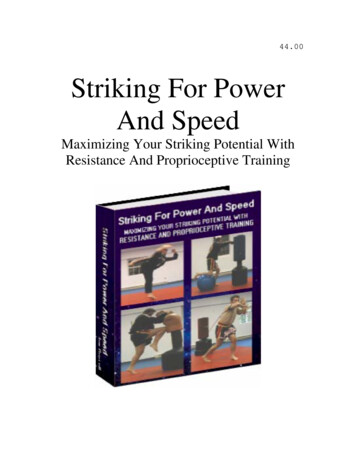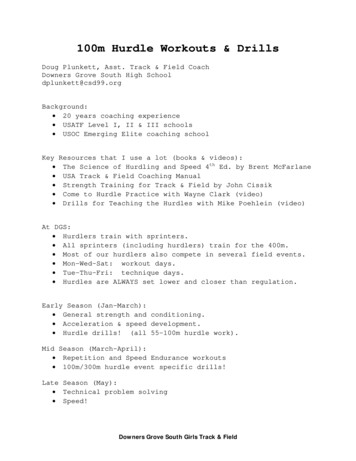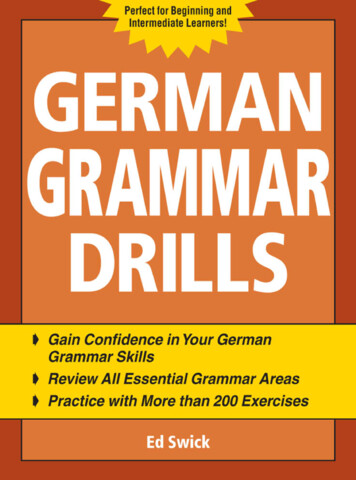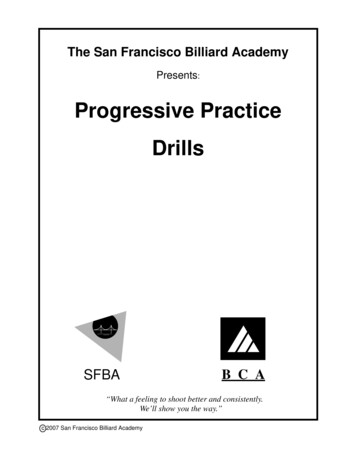
Transcription
The San Francisco Billiard AcademyPresents:Progressive PracticeDrillsSFBAB C A“What a feeling to shoot better and consistently.We’ll show you the way.”c 2007 San Francisco Billiard Academy
Progressive PracticeProgressive Practice DrillsGoal: Improve cue ball control and basic aiming with structured drills.Technique: Shoot a shot that needs a specific skill, and if successful, makethe next shot harder, but if not successful, make the next shot easier. Afterten or so shots, note your skill level.Examples: Two spin drills:8765432REJ1Shoot between the two far balls,and hit the numbered group.56REJ7843Cue ball in hand, spin toget to each location withinnine inches (a hand span).2San Francisco Billiard Academy1Page 1
Progressive PracticeProgressive Practicepermits precise pocketing percentage predictions.By Bob Jewett, originally published in Billiards Digest, Dec. 1992The “progressive practice” method described below has big advantages over standard drills. It automatically adjusts the difficulty of the shots to match your improvement, it lets you measure your percentage foreach kind of shot without any bookkeeping, and it allows you to easily compare your performance on a particular table or day with previous practice sessions. It’s adaptable to many kinds of aiming and positiondrills.Let’s start with a draw drill. In figure 1, the object ball is always near the long rail just out of the pocket jaws.Start with the cue ball in position 1, one diamond from the corner. The goal is to draw the cue ball back atleast to 1. Each time you get enough draw, move the cue ball a diamond further back. For example, if youmake the shot from 1, the next shot is from 2 and you have to draw the cue ball back at least to 2. If you do2, try 3 next.When you miss either the shot or the draw, the cue ball goes a diamond closer to the object ball. If youmiss at 3, your next shot is from 2. Continue adjusting the distance after each shot until you’ve pocketed all15 balls. Note your final position.Let’s grade the result. If you ended at 1 or 2, you get a B for “beginner”. A few minutes of instruction fromthe local pool professor should be beneficial. If you ended between 3 and 5, you get an A for “average.”That’s enough draw for most draw situations. If you ended between 6 and the end rail, chalk up an E for“enough” for nearly all draw shots.Because you make each shot a diamond easier or harder if you miss or make the shot, the final position isclose to your 50% success point. Shorter distances are better than even money for you, while at longerdistances the odds are against you. If you want to know your 50-50 point more accurately, redo the drillstarting from your last position but change the distance only 1/4 diamond each time. The smaller changesresult in a smaller error in the measurement.A somewhat easier progressive drill using the same position is a stop shot. The goal is to pocket the objectball and leave the cue ball within a diamond of the pocket. Ideally the cue ball won’t move at all after it hitsthe object ball.If you need a harder drill, draw the cue back to within a hand span of its starting position. You lose for toomuch or too little draw or wandering away from the rail. Put your thumb tip on the nose of the rail where thecue started. Your little finger must reach to the cue ball for the shot to be good. Very tough to get to 6.A pure aiming drill is shown in figure 2. The object ball starts on the spot, and the cue ball is a diamondfrom the rail. Above average players will be able to turn the corner at position 5. The usual way to practicespot shots is to play from the same position over and over with the dangers of boredom and grooving theaim to a single specific shot. The shots under progressive practice continuously change and force you toaim anew each time.The 50-50 point gives a good mix of challenge and reward which results in rapid improvement, but the system can be modified to find other percentages. To find the point at which you make 2/3 and miss 1/3 of thetime, simply make the position two notches easier when you miss and one notch tougher when you make(where a “notch” might be a quarter diamond). When you’ve settled in on the 67% distance, you’ll maketwo for each one you miss and have no net motion.San Francisco Billiard AcademyPage 2
Progressive PracticeFigure 1REJCue ball positions19234567Figure 27REJ6912345Cue ball positionsWhile you’re at it, don’t forget your other side! The draw drill will be extra tough on the side of the tablewhere it requires either a bridge or shooting wrong-handed. Either way, you can find out how much accuracy you lose on your weak side. For the spot shot, there should be very little difference in the two sides. Ifthere is consistently a large difference, there is likely a fundamental flaw in your aiming or stroke and it’stime to get back to basics.San Francisco Billiard AcademyPage 3
Progressive 1DREJ16Leave the cue ball in thesquare. Do not touch theend rail.Follow forward to leave thecue ball in the shadedarea. Cue and object ballare always one diamondapartREJ6Level 2 shown.CUTSHOTDRAWSHOT122334455676Draw back at least onediamond.7Object ball is 1 inch off therail.San Francisco Billiard AcademyPage 4
Progressive Practice2BREJ2AFOLLOWSHOTREJSTOPSHOT1Level 2 shown.22334455662CLeave the cue ball within9 inches of object balllocation.Leave the cue ball in theshaded area. Do raw back at least as faras the starting point.7Object ball is one ball offthe rail.San Francisco Billiard AcademyPage 5
Progressive Practice3BREJ3AFOLLOWSHOTREJSTOPSHOT1Level 2 shown.22334455663C73DREJ1DRAWSHOT1223344567Follow to scratch. Thecue ball and object ballare always one diamond apart.REJ7Leave the cue ball overlapping the phantom cueball.Draw back as far as thestart but no more than twodiamonds extra.The object ball says put andthe cue ball moves back.CUTSHOT567Object ball is one ball offthe rail.Place the cue ball for a railbridge even with the indicated diamond.San Francisco Billiard AcademyPage 6
Progressive Practice4BREJCue ballin eave the cue ball within9” of the spot. 6 and 7require the end rail.7Leave the cue ballwithin 9” of spot.4DREJ65DRAWSHOTREJ4CCUTSHOT4312213Leave the cueball here.45San Francisco Billiard Academy67Page 7
Progressive FOLLOWSHOT21Leave the cueball within 6” ofspot. Use a railCue ball in hand, leave itwithin 9” of the spot.5DREJ65DRAWSHOTREJ5C4CUTSHOT3423121Leave thecue ball inthe box.Use a rail bridge. For 5-8,line the cue ball up with thesame ball on the foot rail.8 7 6 5San Francisco Billiard AcademyPage 8
Progressive PracticeProgressive Practice LogNameDateSet #ABCDTotalSan Francisco Billiard AcademyScoreCommentPage 9
least to 1. Each time you get enough draw, move the cue ball a diamond further back. For example, if you make the shot from 1, the next shot is from 2 and you have to draw the cue ball back at least to 2. If you do 2, try 3 next. When you miss either the shot or the draw, the cue ball goes a diamond closer to the object ball. If you
